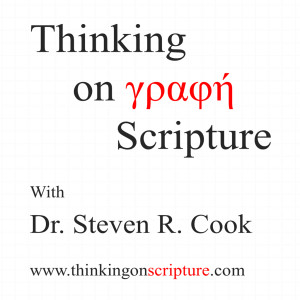
Wednesday Mar 06, 2019
The Day of the Lord
The phrase “the day of the Lord” appears twenty three times in Scripture.[1] It appears eighteen times in the Old Testament (Isa. 13:6, 9; 58:13; Ezek. 13:5; 30:3; Joe 1:15; 2:1, 11, 31; 3:14; Amos 5:18, 20; Obad. 1:15; Zeph. 1:7, 14; Mal. 4:5)[2] and five times in the New Testament (Acts 2:20; 1 Cor. 5:5; 1 Thess. 5:2; 2 Thess. 2:2; 2 Pet. 3:7-14).[3] In Scripture, the “day of the Lord” is used both in a local and future sense. The phrase was first presented by the prophet Joel (assuming he prophesied during the reign of Uzziah), who stated, “Alas for the day! For the day of the LORD is near, and it will come as destruction from the Almighty” (Joe 1:15; cf. 2:1, 11, 31; 3:14). The argument that there is a “day of the Lord” relevant to Joel’s audience is rooted in the historical context of the book in which the prophet wrote to the elders, citizens and the priests in Israel (Joel 1:2, 9, 13). To them, Joel describes the “day of the Lord” within the context of local judgments his audience experienced upon their crops (Joel 1:15). However, there are other biblical passages that describe a future “day of the Lord” which is global and filled with wrath. Some Bible scholars see the “day of the Lord” both as a time of wrath and blessing (Constable & Phillips); whereas other scholars see it strictly as a time of wrath pertaining to the seven year Tribulation (Fruchtenbaum & Wiersbe). The following four quotes respectively demonstrate the view of both camps.
- "The day of the Lord is a term that appears frequently in the Old Testament, especially in the Prophets. It refers to a day in which the Lord is working obviously, in contrast to other days, the day of man, in which man works without any apparent divine intervention…The eschatological day of the Lord that the prophets anticipated includes both judgment (in the Tribulation) and blessing (in the Millennium and beyond)."[4]
- "The day of the Lord is a long period that begins right after the rapture, runs through the great tribulation and the battle of Armageddon, and continues into the millennium. This day, which embraces both judgment and glory, is the subject of extensive Old Testament prophecy, where it is also called “that day,” “a day of wrath,” “the day of vengeance,” and so on."[5]
- "In the Old Testament, the most common name for the Great Tribulation is the Day of Jehovah or the Day of the Lord found in various passages…There are some who use the Day of the Lord to include the Millennium as well as the Tribulation period, based upon 2 Peter 3:10. But as will be shown later in this chapter, this verse is best seen as applying to the Tribulation only, rather than including the events following it. In every passage of the Scriptures that the term the Day of Jehovah or the Day of the Lord is found, it is always and without exception a reference to the Tribulation period. This is the most common name for this period in the Old Testament, and it is also found in various passages of the New Testament. While the phrase that day is used both negatively and positively and therefore many times it does apply to the Millennium, the phrase Day of Jehovah or Day of the Lord is always used negatively and never included the Millennial Kingdom."[6]
- "The phrase “the day of the Lord” refers to that future time when God will pour out His wrath on the Gentile nations because of their sins against the Jews (see Joel 3:1–8). It will occur after the church has been taken to heaven (see 1 Thes. 1:10 and 5:9–10, and Rev. 3:10), during that period of seven years known as the Tribulation. It is described most fully in Rev. 6–19. This period will end with the Battle of Armageddon (Joel 3:9–17; Rev. 19:11–21) and Jesus Christ returning to the earth to establish His kingdom."[7]
I tend to favor the latter view that the future “day of the Lord” refers strictly to the seven year Tribulation. From Scripture we can say with certainty that the future “day of the Lord” follows the first coming of Christ, (Mal. 4:5), will come upon the entire world (Joel 2:1-11; 30-31; 3:12-15; Isa. 13:6-11; Ezek. 30:2-4; Obad. 1:15), will be inescapable (Amos 5:18-20), is a day of wrath and destruction (Zeph. 1:14-18), will come unannounced (1 Thess. 5:1-2; 2 Pet. 3:10), and will follow the coming of the Antichrist (2 Thess. 2:1-4). The church will not experience this time of God’s judgment, for we are waiting for the return of Christ from heaven, “who rescues us from the wrath to come” (1 Thess. 1:10; cf. 5:9).
[1] Old Testament writers use the Hebrew phrase יוֹם־יְהוָה yom Yahweh, and New Testament writers use the Greek phrase ἡμέρα κυρίου hemera kuriou.
[2] The day of the Lord appears twice in Amos 5:18 and Zephaniah 1:14.
[3] Other references include (Isa. 2:11-21; 4:2; 11:10; 13:13; 19:23-24; 24:21; 27:12-13; 30:25; 61:2-4; Jer. 46:10; Ezek. 30:0; 36:33; 38:14-19; Hos. 2:16-21; Joel 3:18; Amos 9:11; Zeph. 1:8-10, 14-15; 2:2-3; 3:8; Mal. 3:2, 17; 4:1-3; Matt. 10:15; 11:22-24; 26:29; Luke 10:12; 17:30-31; Rom. 2:5; Phil. 1:6, 10; 2:16; 1 Thess. 5:4; 2 Pet. 2:9; 1 John 4:17; Rev. 6:19).
[4] Tom Constable, Tom Constable’s Expository Notes on the Bible (Galaxie Software, 2003), Joe 1:15.
[5] John Phillips, Exploring the Minor Prophets: An Expository Commentary, The John Phillips Commentary Series (Kregel Publications; 2009), Joe 1:15–20.
[6] Arnold G. Fruchtenbaum, The Footsteps of the Messiah : A Study of the Sequence of Prophetic Events, Rev. ed. (Tustin, CA: Ariel Ministries, 2003), 172–173.
[7] Warren W. Wiersbe, Wiersbe’s Expository Outlines on the Old Testament (Wheaton, IL: Victor Books, 1993), Joe.
No comments yet. Be the first to say something!